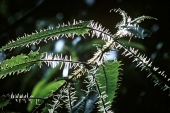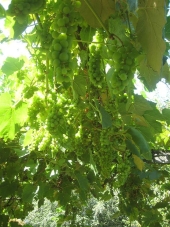posted 12 years ago
I hear you about bindweed. I am lucky to "only" have it in one large infested area of a few hundred square feet. I'm in the process now of covering this area with about two inches of well composted horse manure, then a layer of wood chips, grass that was cut by scythe, more manure and finally more chips. The soil is in an old barnyard but I'm not keeping horses or other large grazers so the area now is truly a waste area. It is badly compacted by past use/misuse. I assume the bindweed won't mind all of the added OM so I plan to cover the entire area with black plastic left over from a construction project last year. I will keep that area covered probably all next growing season. When the cover comes off, finally, the resulting amended soil should be much more conducive to planting more "desirable" species like food plants and supporting ornamentals. I have been surprised to find bindweed in a few spots in some hugelbeets that I thought were free of the plant last year. Those I'm checking every few days and pulling them up. Don't know how it spread to these new spots but it seems to be effective to keep pulling them until they are exhausted. They may be deep rooted but they've got to photosynthesize like all plants. They can't use their root reserves forever. This one species is likely the most pernicious of all that I'm dealing with.
My other big contender is white top (Cardaria sp.). It is perennial, rhizomatous, and so widespread on my place, I will likely never be rid of it entirely. I will say this for white top, it covers disturbed soil with a fairly low decent cover. The bees went crazy over the flowers last year (it's in the mustard family) but didn't seem as busy on them this year. I've kept it mowed/scythed in larger areas and pulled by hand and left to rot on my hugelbeds and raised annual garden beds. It's growing under my pumpkin "forest" at the moment even though I kept pulling it until the pumpkins got going and totally took over the area. My guess is, based on my observations of my more successful hugelbeets, is that Cardaria isn't the most competitive plant out there in areas where other large, fibrous rooted perennials are growing. My abatement tactic will be to continue pulling and using it for mulch and plant heavily so that the rooting zone is filled with other, more desirable species.
For Scotch thistle, I just pull them as I find them. I have far fewer than two years ago. It's biennial and if you see the first year rosette, just pull it up and it's game over.
I've pulled all the spotted knapweed I've encountered. I pulled many dozen last year in one specific area and only pulled three this year so I just have to be watchful for another five to seven years. Based on what I've read, the seed is viable for about seven years in the soil. Unfortunately, it is ignored in many semi-urban areas around, and covers huge areas of wildlands here so it's not going away anytime soon. They are easy to spot this time of year because of their lovely pink flowers. Bees love them, but they are alleopathic and have degraded many tens of thousands of acres of Montana.
Canada thistle is my only other PITA weed. I pull it and mulch with it whenever I am working in an area. It doesn't seem as abundant as two years ago when I moved here. I found a few in the last few days that escaped my watch and have set seed. Those will be cut off and bagged and disposed of with the household garbage.















































